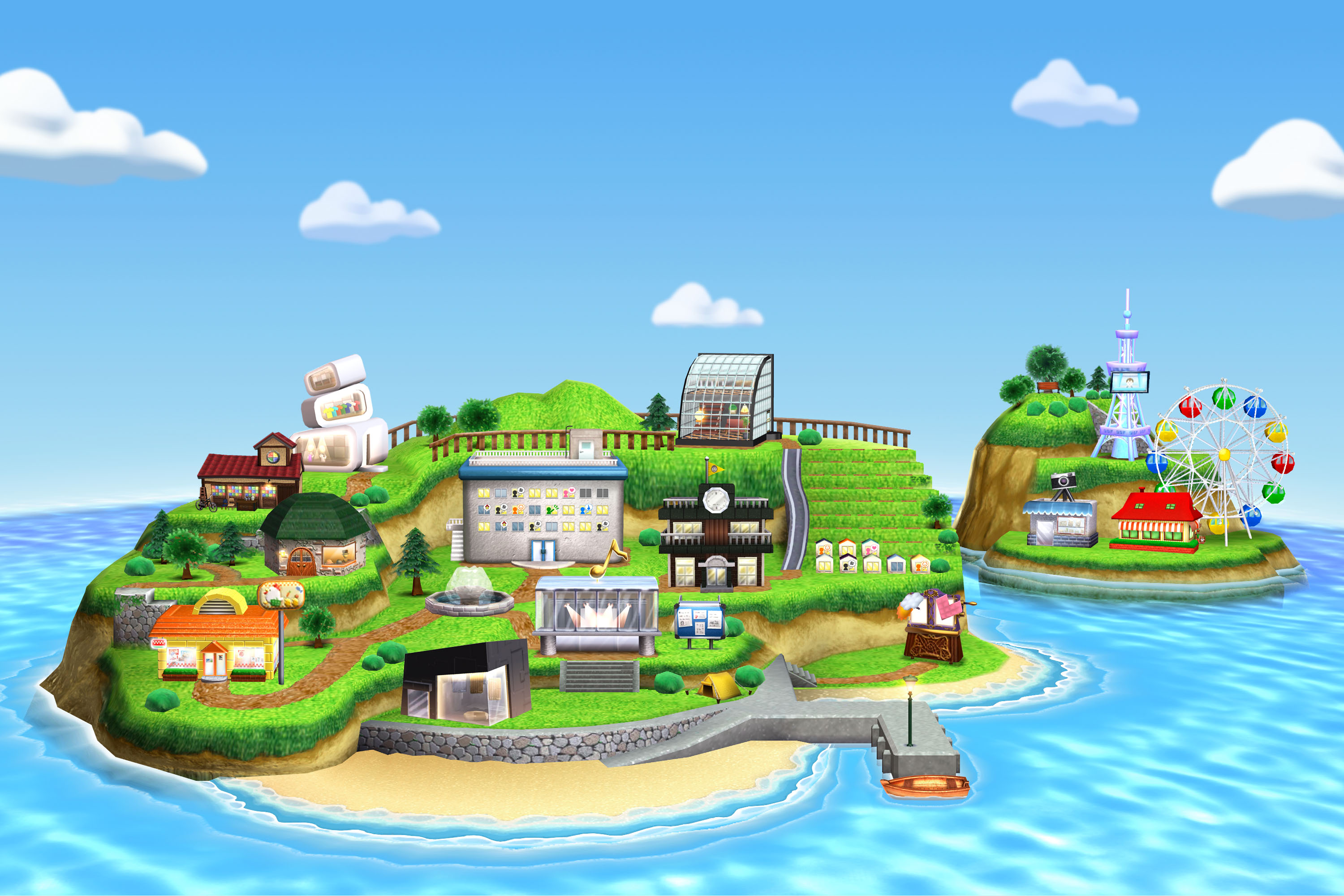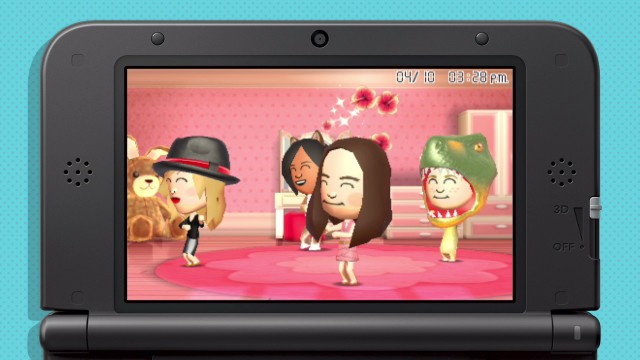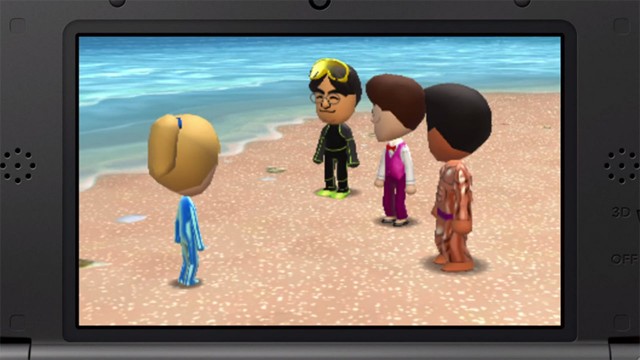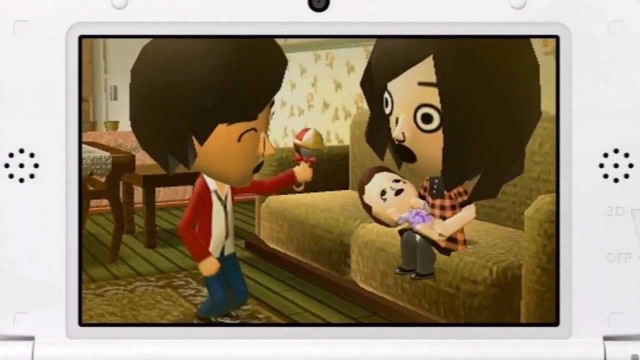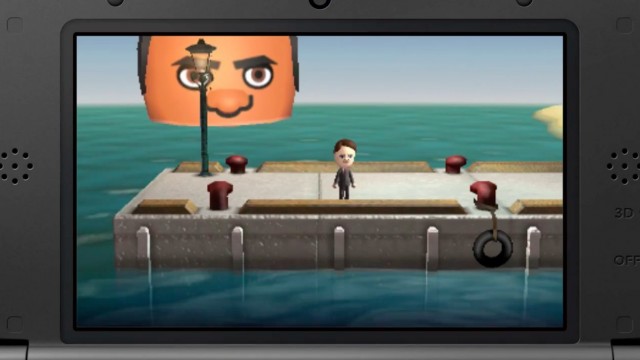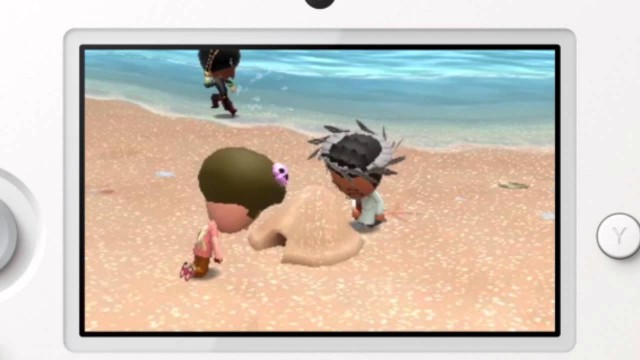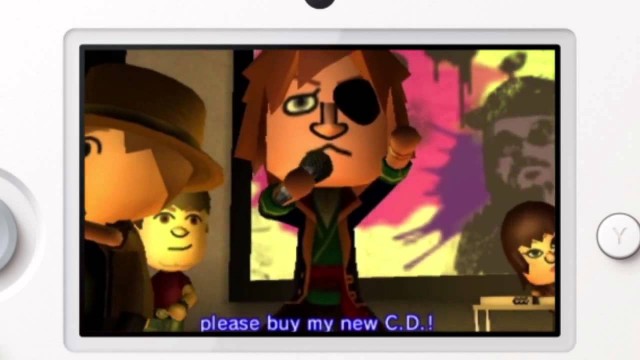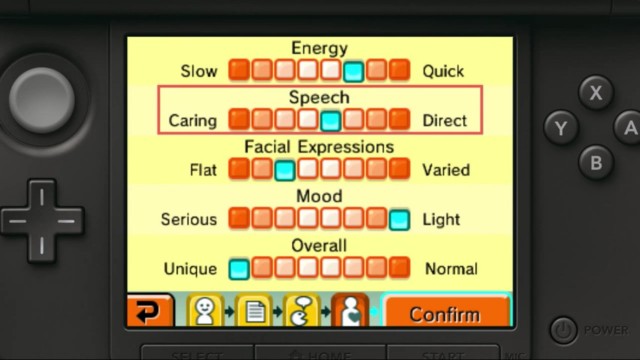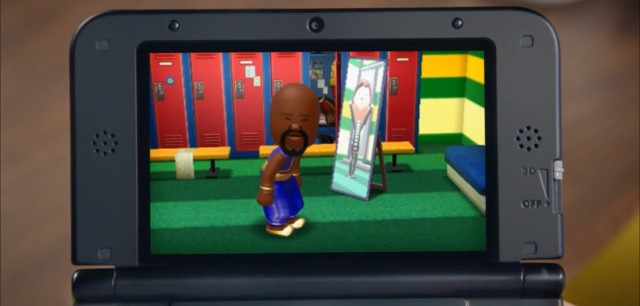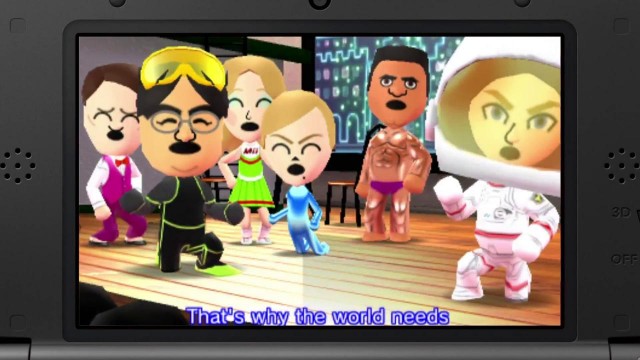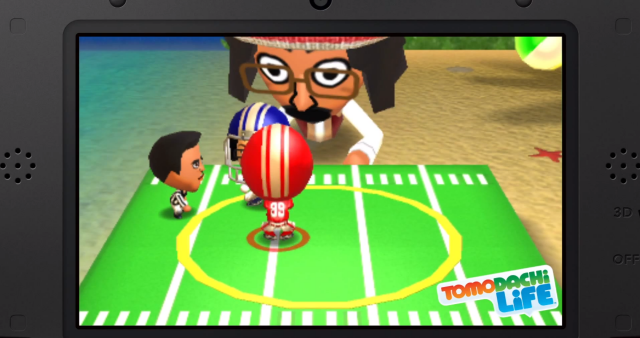Remember virtual pets? The runaway kids’ fad from the 1990’s that disrupted classrooms and annoyed parents before cellphones properly took their place in the following decade?
Well, Tomodachi Life aims to take them to the next level, and thankfully, you can actually turn off Tomodachi Life. Nintendo’s latest 3DS experiment, a sequel to a last-gen DS game from 2009 called Tomodachi Collection that was never released outside of Japan, allows you to put Mii variations of your friends, family, or perhaps even your favourite celebrities or fictional characters, on an island to live and frolic together. You can even name the island! It’s a simple, accessible game, but one that’s more fun and amusing than it has any right to be.
Comparisons to Nintendo’s virtual life darling, Animal Crossing are going to be inevitable here, but Tomodachi Life is a very different kind of game in contrast to Animal Crossing. It’s not as deep, but it’s also not as demanding, being more of a glorified social toy than a full-fledged video game experience.
If Nintendo made games for mobile devices, Tomodachi Life would probably be something they would come up with for your smartphone or tablet. There’s not a lot to it, and it probably won’t hold the attention of more hardcore gamers, nor people who don’t care for virtual life or social games, but if you’re looking for something cute and accessible to unwind with on your 3DS/2DS, Tomodachi Life makes for a nicely quirky distraction, even if it could have presented a better value.
Tomodachi Life is a rather unassuming-looking game. It almost looks like the last-gen DS could pull it off to at least some degree, but that’s not to say it’s ugly. It’s more accurately, quaint.
Some of the island locations look decently colourful, and there’s definitely plenty of character to some of the interior decorating options on offer for your Mii apartments. A few of the other locations across your island are snazzy too, namely the concert hall and observation tower.
The highlight of the visuals is arguably the often manic and highly expressive Mii animations though, which are admittedly funny and likeable. You’ve never seen Mii characters come to life quite like this before, and some of the actions that your Mii’s can perform together really give the little avatars more personality than they’ve ever had. Even just watching a Mii fool around on a white background while you’re waiting for your game to save is difficult not to at least smile at.
Naturally, there is also a 3D effect for those playing on a 3DS or 3DS XL as well. It’s a pretty potent 3D effect to boot, and it does add some atmosphere to your concerts and apartments. It’s far from essential however, and those playing on a 2DS, or simply opting to switch off the 3D Slider, really aren’t missing anything.
The same simple charm of the gameplay is felt in the rather straightforward visuals. Tomodachi Life is obviously not a game meant to stimulate, but to amuse, and that wholesomeness is found in the basic, but serviceable art style.
For all of its quirky energy, Tomodachi Life’s soundtrack entirely consists of relaxed, serene music. Watching your Mii characters interact, get into mischief, mess around, and just generally show off their wacky personalities is complemented by a ‘home sweet home’ vibe from the music, which is just as quaint and simple as the graphics.
Sound effects are also predictable and very simplistic, though blatantly Nintendo-esque. They feel like the same kooky effects that play when you navigate the base menus of your Nintendo devices, with some extra character given to sounds like a Mii munching on a plate of food, or perhaps tinkering with some object that you gave to them as an amusing toy.
What’s most surprising about Tomodachi Life however, and strangely revolutionary for Nintendo in general actually, is that any Mii you put on the island is fully voiced! Mii characters will speak to you, including reciting names you give to them, and you have some degree of control over what kind of voice you give them, including the ability to mis-match certain voices with certain genders or ages, Saints Row-style.
It’s initially shocking and soon after endearing to hear a Mii talk to you as if you were actually there. It also helps to give them extra character when they beg you for food, clothes and decorations as well. The only minor issue here is the fact that their monotone robot voices don’t really do a great job at communicating actual emotions, since there’s obviously a programming algorithm in the game that focuses on pronouncing words, not understanding the meaning behind them.
It may also be unfair to say, but the robotic voices can be a bit creepy in some cases as well, especially for any adult Mii you make. It’s frustrating, because the potentially off-putting, emotionless voices are often at odds with the personality-filled actions and antics that any given Mii could get up to at any point.
All in all though, this is another audio job that works well. Even with some expected drawbacks, the amount of effort put into giving a Mii speech capability in particular is something that’s very ambitious, and just as commendable!
While you do have freedom to customize a Mii in terms of their appearance and basic personality, much of Tomodachi Life is played as an observer. This is one of the main things that separates Tomodachi Life from Animal Crossing. Animal Crossing is all about actively working to build up capital, improve your town, and naturally, pimp out your house with decorations and other pretty scenery.
Tomodachi Life on the other hand is a much more passive experience. The core appeal of the game comes from the fact that you don’t actually have control over your Mii population, nor what they may do at any given point. It sounds lazy on paper, but in practice, it leads to a sense of novelty and surprise that will keep players coming back to see what other shenanigans their islanders will get up to on any given day.
Beyond creating Mii characters and populating your island with them, and watching them mess around naturally, you do solve simple issues that they come to you with. This is where the game is comparable to the virtual pets of yesteryear. Between any given day, a Mii may be hungry, or may desire new clothes, or may want to make a friend and ask you for advice, among other things.
These tasks are always very simple to accomplish, and performing any of them will net you money that you can save up and spend on more food, clothes, decorations, and more for any Mii you wish. You often just have to buy a Mii something they like, or give them an answer that makes sense on some level. If they get sad, such as if they are rejected by a fellow Mii that they develop romantic feelings for, you can give them a toy to cheer them up as well.
Yes, your Mii population can romance each other in Tomodachi Life, and the fact that it’s completely out of a player’s control, beyond occasionally contributing advice, can lead to all sorts of unexpected and funny surprises, especially if you use your real-life friends and family as the basis of your Mii characters. You can thankfully specify which Mii’s are related to each other as well, to avoid any awkwardness there.
Not only can Mii’s become ‘sweethearts’, but they can also even get married and have children together. Seeing prospective children can also be interesting, even if it’s a tad odd that baby Mii’s will grow into adult Mii’s very quickly, often in just a day or two! Apparently, Mii biology is very, very different from actual human biology!
Here however, the controversy must be addressed; No, Tomodachi Life does not allow same-sex relationships and marriages. This caused an online uproar when Nintendo patched out a bug in the initial Japanese release that allowed Mii’s of the same sex to enter a relationship, but it is genuinely baffling that Nintendo has opted not to accommodate the LGBT community in Tomodachi Life in the first place.
There is a bit of a workaround, since you can lie about a Mii’s gender, and there are no limits to how a Mii can be customized in terms of appearance, so you could just, say, claim a gay man is a female Mii and just make the Mii look like the man in question. Still, this isn’t a perfect solution.
Nintendo has claimed that they will consider same-sex relationships in potential follow-ups to Tomodachi Life, but even for people outside of the LGBT community, it is a disappointing omission. I’m a straight, cisgendered person myself, and, frankly, the majority of gamers and the world’s population are, that’s true. Even then however, I have homosexual and transgendered friends that I can’t represent properly in Tomodachi Life now, especially if I want to include their partners. For a game released in 2014, this insistence on straight, cisgender characters comes off as undeniably backwards.
In any case, at least Mii’s making friends and performing all sorts of fun, quirky actions is consistently fair game. As you solve the problems of your Mii characters, they’ll ‘level up’, allowing you to give them more gifts, teach them new phrases and actions, and even teach them songs. Once your Mii’s learn songs, they can even perform concerts across several genres of music, complete with other Mii’s as their background dancers. You can create some funny compositions with the ability to change the words in their tunes, though, as with any other portion of Tomodachi Life, you can’t curse, nor use hateful and/or offensive language.
As you perform actions and create more Mii’s for your island, new locations will open up, and thus, new activities. You can even gain the ability to send Mii’s and treasures off to other players using StreetPass, which is another good way to build up the population and swag on your custom island. As you unlock more places for your Mii’s to go, and more goodies you can share with them, cute news reports will detail each expansion to your island, complete with kooky quotes from the Mii’s that live there, with one even taking on the role of newscaster.
Ultimately though, this is pretty much all you do in Tomodachi Life; Check back every so often with your Mii’s, solve their simplistic problems, occasionally play a dull minigame with them (which range from memory games to trivia to a few other things), and buy things to keep gradually pimping out your Mii apartments. This is why the game feels like more of a virtual toy than an actual video game.
With that comes the other ugly reality that, for many players, the novelty of Tomodachi Life can wear off quicker than you would expect. The game can be full of delightful surprises and fun kookiness, certainly, and you definitely won’t often get the sense that you know what to expect in advance as your Mii’s bumble about your island, especially when they interact with each other.
As a full $39.99 retail game in the 3DS library however, Tomodachi Life feels rather overpriced. Had it been a dedicated 3DS eShop game for about half that price, it would have presented a much better value. Being a full retail offering however, Tomodachi Life does feel like it’s sometimes wanting for more depth, especially compared to something like Animal Crossing: New Leaf, which has a much more expansive and deeper wealth of activities and rewards.
There is definitely fun and amusement to be had with Tomodachi Life’s unpredictable nature, but when you realize that you’re no longer amused by the exaggerated actions and bizarre hobbies of your Mii population, the game’s value plummets pretty fast. It’s nice that Tomodachi Life is so accessible, and that its characters don’t have that passive-aggressive neediness that Animal Crossing: New Leaf’s population is guilty of if you put the game down for a considerable amount of time, but maybe it needed a bit more than personality to have a better shot at continually keeping people coming back.
Tomodachi Life is a solid virtual life game that isn’t wanting for charm or personality. It begs the question of how much a game can sell itself on just charm though. It’s difficult not to love your Mii population’s hijinx, but given the lack of depth in the package, Tomodachi Life just feels like it’s missing that extra something, especially for a full retail 3DS game commanding a $39.99 price tag.
If money is no object to you, and you love the idea of watching caricatures of your friends get up to mischief and fool around together at their leisure, then Tomodachi Life is an amusing experience while it lasts. If you’re looking for a game that you can really dive into and play for hours on your 3DS/2DS however, this isn’t it. In that case, you’re better off sticking with Animal Crossing: New Leaf for your virtual life fix.
Nintendo may be on to something with this undeniably upbeat formula, but it can definitely be taken further. Here’s hoping that a sequel can fully realize the potential of what’s currently a loveable, but rather fleeting experience.

